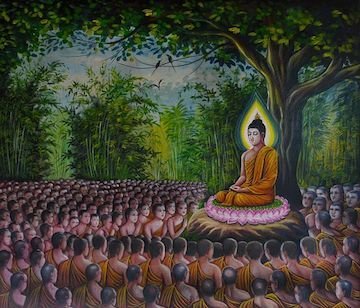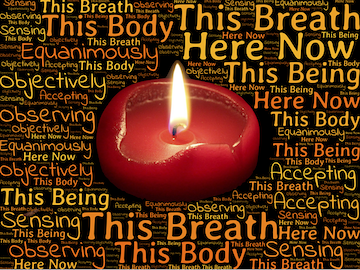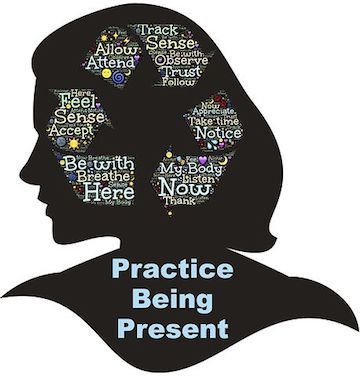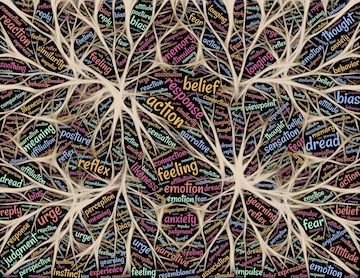The Buddhist 10 Fold Path
7. RIGHT MINDFULNESS

As the seventh part of the Eight-fold Path, Right Mindfulness forms a close link with Right Intention and Right Thought, as they are practiced together. This practice is applied for the mind’s establishment of wholesome qualities and to stabilize the mind itself, in relation to the body, as well as towards feelings:
“And what, friends, is right mindfulness? Here a monk abides contemplating the body as a body, ardent, fully aware, and mindful, having put away covetousness and grief for the world. He abides contemplating feelings as feelings, ardent, fully aware, and mindful, having put away covetousness and grief for the world. He abides contemplating mind as mind, ardent, fully aware, and mindful, having put away covetousness and grief for the world. He abides contemplating mind-objects as mind-objects, ardent, fully aware, and mindful, having put away covetousness and grief for the world. This is called right mindfulness.” — MN III.252
Two important teachings in the Pali Canon cover the topic of mindfulness in great detail, in it’s condensed form in the Satipatthana Sutta (Majjhima Nikaya) and the very elaborate version of it in the Maha-Satipatthana Sutta (Digha Nikaya).
To get an indication of why right mindfulness (and the entire Eight-fold Path) is practiced, the Satipatthana Sutta opens with this great reason:

“Monks, this is the direct path for the purification of beings, for the surmounting of sorrow and lamentation, for the disappearance of pain and grief, for the attainment of the true way, for the realisation of Nibbana—namely, the four foundations of mindfulness.’’ — MN I.56
The four Foundations of Mindfulness (satipatthana) are to be developed as part of Right Mindfullness, and have as their object of contemplation: the body, feeling, mind, and mind-objects:

“And how, monks, does a monk abide contemplating the body as a body? Here a monk, gone to the forest or to the root of a tree or to an empty hut, sits down; having folded his legs crosswise, set his body erect, and established mindfulness in front of him, ever mindful he breathes in, mindful he breathes out.
Their resulting insight that should be the fruit of it’s practice is explained; the insight relates both internally and externally, it’s arising and cessation, and the importance of non-clinging [to anything in this world]:

Or else mindfulness that ‘there is a body’ is simply established in him to the extent necessary for bare knowledge and mindfulness.
And he abides independent, not clinging to anything in the world.” — MN I.56
The contemplation of the mind [as mind] is a more complex practice relating to the hindrances of lust, hate, and delusion; as well as the states of the mind as a whole:

“And how, monk, does a monk abide contemplating mind as mind?
He understands liberated mind [due to meditative attainment] as liberated mind, and non-liberated mind as non-liberated mind.” — MN I.59
The mind-objects are another form of contemplative practice that are used to accentuate the five hindrances (sensual desire, ill will, laziness, restlessness, and doubt) that keeps one back from going further along the path:

“And how, monks, does a monk abide contemplating mind-objects as mind-objects? Here a bhikkhu abides contemplating mind-objects as mind-objects in terms of the five hindrances. And how does a bhikkhu abide contemplating mind-objects as mind-objects in terms of the five hindrances?
The extreme importance of the four Foundations of Mindfulness is given in the conclusion of the teaching:

“Monks, if anyone should develop these four foundations of mindfulness in such a way for seven years [let alone for 7 days!], one of two fruits could be expected for him: either final knowledge here and now, or if there is a trace of clinging left, non-return.” — MN I.62
In all, Right Mindfulness is a key practice on the noble Eight-fold Path.


The Nikayas are Buddhist books that form the earliest Buddhist canon of scriptures containing the teachings of the Buddha.
First of all, it really helps to have these books in digital form, so you can search for a particular word easily and be able to read how it is mentioned and in what context it is placed in the teachings of the Buddha.
The following English translations of the primary texts are available and used:
- The Connected Discourses of the Buddha: A Translation of the Samyutta Nikaya (SN)
- The Long Discourses of the Buddha: A Translation of the Digha Nikaya (DN)
- The Middle-Length Discourses of the Buddha: A Translation of the Majjhima Nikaya (MN)
- The Numerical Discourses of the Buddha: A Translation of the Anguttara Nikaya (AN
B. The Virtue and Moral Discipline aggregate of training
- Right livelihood (samma-ajiva)
C. The Concentration aggregate of training
- Right effort (samma-vayama)
- Right mindfulness (samma-sati)
- Right concentration (samma-samadhi)
The Ten-fold Path consists of two additional ‘folds’:
- Right knowledge / wisdom (samma-nana)
- Right liberation / release (samma-vimutti)
- AN = Anguttara Nikaya,
- DN = Digha Nikaya,
- MN = Majjhima Nikaya,
- SN= Samyutta Nikaya); followed by book number in roman capitalized numerals and verse number (for example, AN I.30 = Anguttara Nikaya book 1 verse 30).
Note: Quotations follow the PTS (Pali Text Society) naming and numbering format:
I will flag comment spam at 1% strength. If you keep on spamming my post I will flag you at 100%. I don't care if you have limited English abilities write a couple sentences about this article, no copy-paste please. I will flag: one sentence comments, links to your blog and begging for up-votes and follows. Also I will flag comments that have nothing to do with my blogs article. I will also check your comment section to see if you have been comment spamming on other blogs.


 A link to My Blog
A link to My Blog
This teachings are really interesting
From what i learnt from todays teachings, been able to condition the mind is the key to state of wholesomeness
Since we know that the mind affected by hate is really a mind affected by hate, it just absolute and makes us aware that it is just not disputable.
Our mindset really matters and the way we see things as they are is really what they are. Love is love as long as the perception of the mind is that it is love.
In conclusion, the bedrock of our perception of things is the mindset we have towards it. Rightful mindset go a long way in helping us live right.
Never knew buddhist teachings can be this in dept and interesting.
Now i understand why they do this.
This was really an expository and exhaustive teaching.
Expectantly waiting for the next teaching
Nice article @reddust.
Thank you @cyprianj for a thoughtful reply on the content of this post. If the mind is colored by negative, unwholesome thoughts, that will be all you see. If you feel hateful, everything you see and do will be colored by hate.
Wholesome mind states like loving kindness and compassion must have wisdom as a support. As my teachers told me there is foolish kindness and compassion, which can cause as much trouble for everyone as hate and anger.
I will be getting into wisdom in the later post on the 10 fold path, there are several definitions and their meaning is contextual.
Metta means wise loving kindness in Pali (it's a dead language like Latin)
Much metta and thank you
Interesting how you break down the different facets of the mind and the effect on the miind. I believe it is like a computer - that kept clean from viruses and impurities can operate miraculously. Thanks @reddust.
Unlike a computer we are sentient beings and are able to know what is self and not self. I have often felt that the computer is much like how we store data, it's humans that made computers anyway. My brain is incased in a thick skull which does not see, taste, hear, feel, or touch.
I used to freak myself out by contemplating I see the world through darkness, everything sound, light, feeling, taste, smells are just vibrations translated by the brain which is a sense organ too. Buddhist text have several words for mind and their meaning is based on how they are used with other words in the sentence. It gets complicated...It's easier to meditate and see how naked sensation is translated into thoughts and actions rather than try and talk about it...hahaha
When I talk about mind in relation to the article, next time I will try and give the Pali word and link about it's origins and definitions.
Words are so small :p
@reddust,
My dear Buddhist friend "Theruwan Saranayi" - Triple Gem Bless You!
In Sinhala
තෙරුවන් සරණයි
Mindfulness is to be aware of happenings (reality of present moment) all the time in your physical boundary and even outside. The awareness of the interaction of outside objects with/within physical boundaries is done with Mindfulness. This is a very simple crude definition.
Mindfulness is related to the constantly changing body and mind sensations, they are like a bubble, just one touch and they pop...how can you take them seriously? From the Phena Sutta
Almost there, you just need to see the flux of phenomena as it really is without the overlay of conditioning.
Thank you for sharing this @reddust! I think a lot of people who think themselves "spiritual" practice aspects of Buddhism as part of their lives, but it's nice to know (formally) where these ideas actually originate.
Bright Blessings!
I don't know if I agree that this is a spiritual practice because spiritual is a vague word. Having said that the formal training is like learning to make bread. Most of us start out with a recipe that we know works. Usually from someone who is an expert at making bread. After learning the recipe and becoming a expert bread maker we can make our own variations on the original recipe. But the basics are always the same. That is where formal training comes in handy. Also having a teacher keeps beginner delusions of grandeur or doubt in check.
Spiritual is, indeed, a vague and often misused word. In this case, I think of it as meaning something you engage in "for the spirit."
i am truly happy to see this being shared with others..even though i know how to explain them in my native language my english knowledge is not that good to be shared them in english..so im very happy to see somebody sharing these very meaningful things with others and letting them know the true worth of this philosophy..you are doing a very good thing..at the same time it is a very big merit :)
Mental discipline can be done by anyone, it isn't a religious practice. Thank you for sharing @steemclaira!
always with amazing valuble posts, about the best way we should live life, indeed as i said always such a great think to live life depending on buddhism because it's a really great way for living stright life. thank you dear.
Thank you @yassinof
Wow !!! Nice informative post....
Thank you @prince121
Meditation is one of the best way to clam our mind.... sometimes I apply it when I am so depressed.... it’s really works ...
Thank you @prova
amazing teachings of buddhist :)taking right decisions at right time always keep peace in life :)
Thank you @munazza